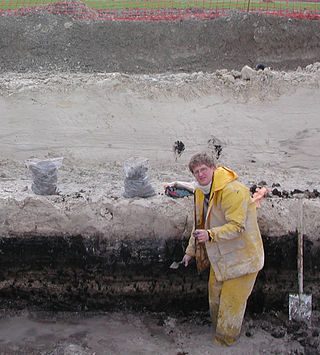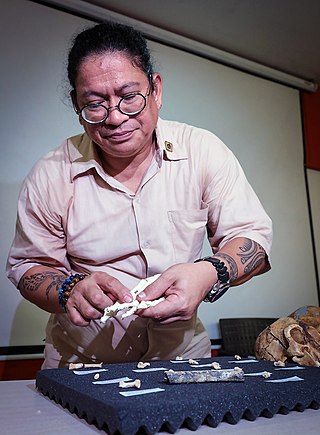
Geoarchaeology is a multi-disciplinary approach which uses the techniques and subject matter of geography, geology, geophysics and other Earth sciences to examine topics which inform archaeological knowledge and thought. Geoarchaeologists study the natural physical processes that affect archaeological sites such as geomorphology, the formation of sites through geological processes and the effects on buried sites and artifacts post-deposition. Geoarchaeologists' work frequently involves studying soil and sediments as well as other geographical concepts to contribute an archaeological study. Geoarchaeologists may also use computer cartography, geographic information systems (GIS) and digital elevation models (DEM) in combination with disciplines from human and social sciences and earth sciences. Geoarchaeology is important to society because it informs archaeologists about the geomorphology of the soil, sediment, and rocks on the buried sites and artifacts they are researching. By doing this, scientists are able to locate ancient cities and artifacts and estimate by the quality of soil how "prehistoric" they really are. Geoarchaeology is considered a sub-field of environmental archaeology because soil can be altered by human behavior, which archaeologists are then able to study and reconstruct past landscapes and conditions.
The Yarmouthian stage and the Yarmouth Interglacial were part of a now obsolete geologic timescale of the early Quaternary of North America.
Roald Hilding Fryxell was an American educator, geologist and archaeologist. He was a Professor of Anthropology at Washington State University (WSU) and pioneer in the interdisciplinary field of geoarchaeology, with a career that involved work on monumental projects in North America and even outer space.
Cactus Hill is an archaeological site in southeastern Virginia, United States, located on sand dunes above the Nottoway River about 45 miles south of Richmond. The site receives its name from the prickly pear cacti that can be found growing abundantly on-site in the sandy soil. Cactus Hill may be one of the oldest archaeological sites in the Americas. If proven to have been inhabited 16,000 to 20,000 years ago, it would provide supporting evidence for pre-Clovis occupation of the Americas. The site has yielded multiple levels of prehistoric inhabitance with two discrete levels of early Paleo-Indian activity.
Patrick M.M.A. Bringmans was born 28 November 1970 in Hasselt, Belgium to Albert and Elly Bringmans-Jans. He is a Belgian archaeologist and paleoanthropologist whose main field of study has been the Palaeolithic period.

Azykh Cave, also referred to as Azokh Cave, is a six-cave complex in Azerbaijan, known as a habitation site of prehistoric humans. It is situated near the village of Azykh in the Khojavend District.

Amos Frumkin is an Israeli geologist and speleologist.
Vance T. Holliday is a professor in the School of Anthropology and the department of Geosciences as well as an adjunct professor in the department of Geography at the University of Arizona in Tucson.
Dust Cave is a Paleoindian archaeology site located in northern Alabama. It is in the Highland Rim in the limestone bluffs that overlook Coffee Slough, a tributary of the Tennessee River. The site was occupied during the Pleistocene and early Holocene eras. 1LU496, another name for Dust Cave, was occupied seasonally for 7,000 years. The cave was discovered in 1984 by Dr. Richard Cobb and initially excavated in 1989 under Dr. Boyce Driskell from the University of Alabama.
Michael Waters is an American academic working as a professor of anthropology and geography at Texas A&M University, where he holds the Endowed Chair in First American Studies. He specializes in geoarchaeology, and has applied this method to the investigation of Clovis and later Paleo-Indian, and possible pre-Clovis occupation sites.

Gail Ashley, née Mowry, is an American sedimentologist. She is known for her studies of the Olduvai Gorge sediments, focused on the water supplies available to hominids and the paleoclimate of the region. She has participated in multi-disciplinary projects that include meteorology, oceanography, paleoanthropology, and archaeology. She has served in professional organizations in the fields of sedimentology and geology, including the presidency of the Geological Society of America, the second woman to hold that post.
Rolfe D. Mandel is a Distinguished Professor of archaeology in the Department of Anthropology at the University of Kansas as well as Senior Scientist and Executive Director of the Odyssey Geoarchaeological Research Program at the Kansas Geological Survey. Initially trained as a geographer, he has been a major figure in defining the subdiscipline of geoarchaeology and has spent the last thirty years focusing on the effects of geologic processes on the archaeological record. His primary research interests include geoarchaeology, Quaternary soils, geology, paleoecology, and paleoenvironmental reconstruction in the Great Plains region of the United States as well as the Mediterranean. Over the years, Mandel has participated in numerous research projects and has served as an editor to multiple journals and a book. His work has been key in promoting an interdisciplinary approach in archaeology, geology, and geography.

Julie K. Stein is an American geoarchaeologist, who is best known for her research on the coastal adaptions of prehistoric humans in the Pacific Northwest. She is executive director of the Burke Museum of Natural History and Culture and Professor of Anthropology at the University of Washington.
The Cambridge Manuals in Archaeology form a book series published by Cambridge University Press in the field of archaeology.
Lisa-Marie Shillito is a British archaeologist and senior lecturer in landscape archaeology as well as director of the Wolfson Archaeology Laboratory and Earthslides at Newcastle University. Her practical work focuses on using soil micromorphology, phytolith analysis and geochemistry in order to understand human behaviour and landscape change. Her work includes the Neolithic settlements of Çatalhöyük in Turkey and Ness of Brodgar and Durrington Walls in Britain, but also Crusader castles and medieval settlements in Poland and the Baltic and in the Near East.

Carolina Mallol was born in Barcelona, Spain in 1973, and is a professor and researcher of archaeological science at the University of La Laguna in Tenerife, Spain.

Armand Salvador B. Mijares is a Filipino archaeologist from Manila, Philippines. He works as Professor of Archaeology at the Archaeological Studies Program of the University of the Philippines-Diliman. He specializes in lithic analysis, ceramic petrology, soil micromorphology, paleolithic archaeology and early human migration in Southeast Asia. In 2010, Mijares gained international attention as the main author of a Journal of Human Evolution report about a 67,000-year old foot bone discovered in Callao Cave. That report gave evidence for the newly named species of Homo, called Homo luzonensis, named after the Philippines' largest island—Luzon. The discovery has advanced the complexity of early human colonization of Southeast Asia.

Wendy Matthews is a British archaeologist and academic, specialising in Neolithic and Bronze Age Near Eastern archaeology and Geoarchaeology. She is an associate professor at the University of Reading since October 2000.
Ashok Kumar Singhvi is an Indian geoscientist and former Dean of Physical Research Laboratory. His field of expertise is Geophysics, Quaternary Sciences and Quantitative Geomorphology.

Silvia Frisia is a professor of Earth Science at the University of Newcastle, Australia. Frisia's work on carbonate crystals as archives of Earth's past environments and climates is recognised internationally. Her recent work has focussed on the role of Antarctic volcanism on the Southern Ocean.








